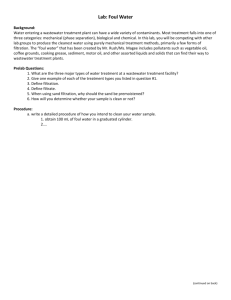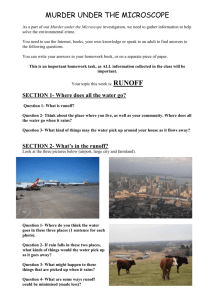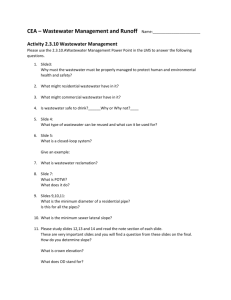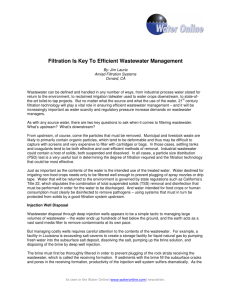Water Test date: Monday, February 11th Study Guide Chapter Three
advertisement
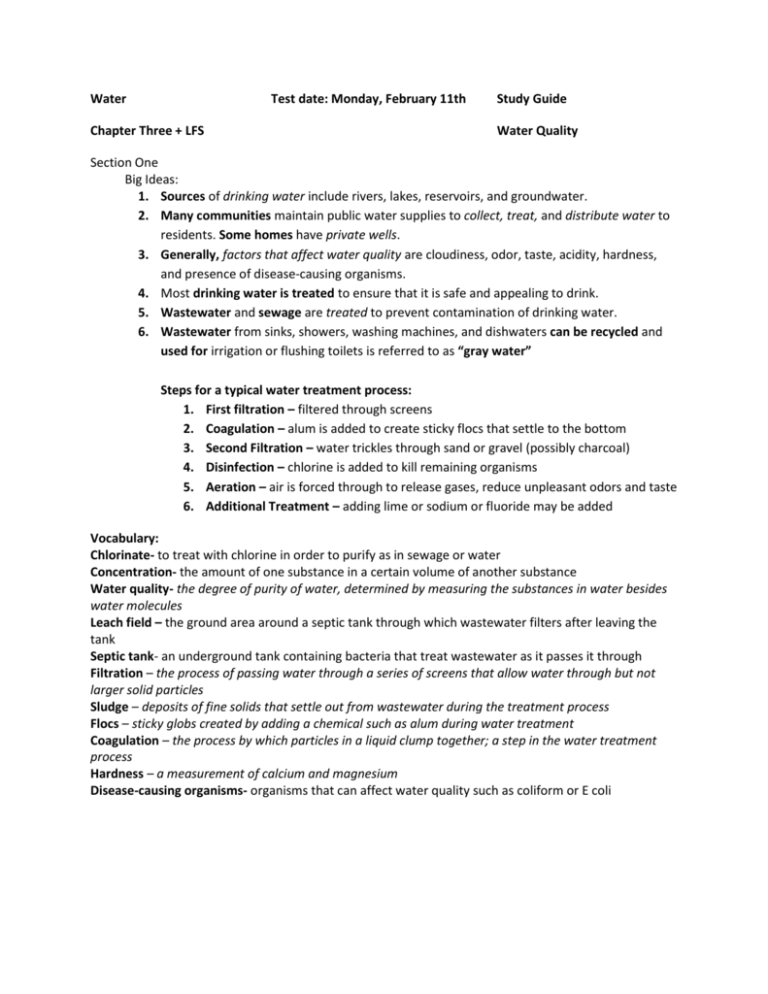
Water Test date: Monday, February 11th Chapter Three + LFS Study Guide Water Quality Section One Big Ideas: 1. Sources of drinking water include rivers, lakes, reservoirs, and groundwater. 2. Many communities maintain public water supplies to collect, treat, and distribute water to residents. Some homes have private wells. 3. Generally, factors that affect water quality are cloudiness, odor, taste, acidity, hardness, and presence of disease-causing organisms. 4. Most drinking water is treated to ensure that it is safe and appealing to drink. 5. Wastewater and sewage are treated to prevent contamination of drinking water. 6. Wastewater from sinks, showers, washing machines, and dishwaters can be recycled and used for irrigation or flushing toilets is referred to as “gray water” Steps for a typical water treatment process: 1. First filtration – filtered through screens 2. Coagulation – alum is added to create sticky flocs that settle to the bottom 3. Second Filtration – water trickles through sand or gravel (possibly charcoal) 4. Disinfection – chlorine is added to kill remaining organisms 5. Aeration – air is forced through to release gases, reduce unpleasant odors and taste 6. Additional Treatment – adding lime or sodium or fluoride may be added Vocabulary: Chlorinate- to treat with chlorine in order to purify as in sewage or water Concentration- the amount of one substance in a certain volume of another substance Water quality- the degree of purity of water, determined by measuring the substances in water besides water molecules Leach field – the ground area around a septic tank through which wastewater filters after leaving the tank Septic tank- an underground tank containing bacteria that treat wastewater as it passes it through Filtration – the process of passing water through a series of screens that allow water through but not larger solid particles Sludge – deposits of fine solids that settle out from wastewater during the treatment process Flocs – sticky globs created by adding a chemical such as alum during water treatment Coagulation – the process by which particles in a liquid clump together; a step in the water treatment process Hardness – a measurement of calcium and magnesium Disease-causing organisms- organisms that can affect water quality such as coliform or E coli Section Three Big Ideas: 1. Sources of water pollution include human and animal wastes(coliform), industrial (chemicals, smoke and exhaust, heat), agricultural chemicals (pesticides and fertilizers), sediments, and runoff from roads. 2. Leading cause of surface water pollution is from agricultural sources. A high level of nutrients is likely to cause eutrophication, greatly reducing the amount of dissolved oxygen in a body of water. 3. Acid rain is caused by sulfur and nitrogen from smokestacks and car exhausts, mainly from the burning of fossil fuels. Acid rain level in PA is about 4.08 while an average rain would be about 5.6. Acid rain falling into a lake in PA would lower its pH, possibly hurting some of the fish that live there. 4. According to World Health Organization (WHO), about 3 million people die every year, mostly under the age of five, as a result of water pollutants. Vocabulary: pollutant- any substance that pollutes or impurifies point source- a specific source of pollution that can be identified; easy to identify, monitor, and regulate; examples- drain pipes, ditches, sewer lines) nonpoint source- a widely spread source of pollution that is difficult to link to a specific point of origin, such as road runoff; difficult to control; examples – atmospheric deposition, agricultural/industrial /residential runoff pH- how acidic or basic a substance is, measured on a scale of 1(very acidic)-14(very basic) sewage- water containing human wastes fertilizers – any substance added to the soil to make it more productive plant life pesticides- chemicals intended to kill insects and other organisms that damage crops phosphates –a chemical salt used in fertilizers clear-cutting- the process of cutting down all trees in an area at once will increase sediments in nearby water sources biomagnification- the sequence of processes in an ecosystem by which higher concentrations of a particular chemical, such as the pesticide DDT, are reached in organisms higher up on the food chain through a series of predator-prey relationships bioaccumulation – the increase in the concentration of a chemical in the tissue of an organism over time. acid rain- rain that is more acidic than normal Review the many activities (lab, simulations, etc.) that we did in class. You can do this by reviewing your notebook. If you kept an organized notebook.
